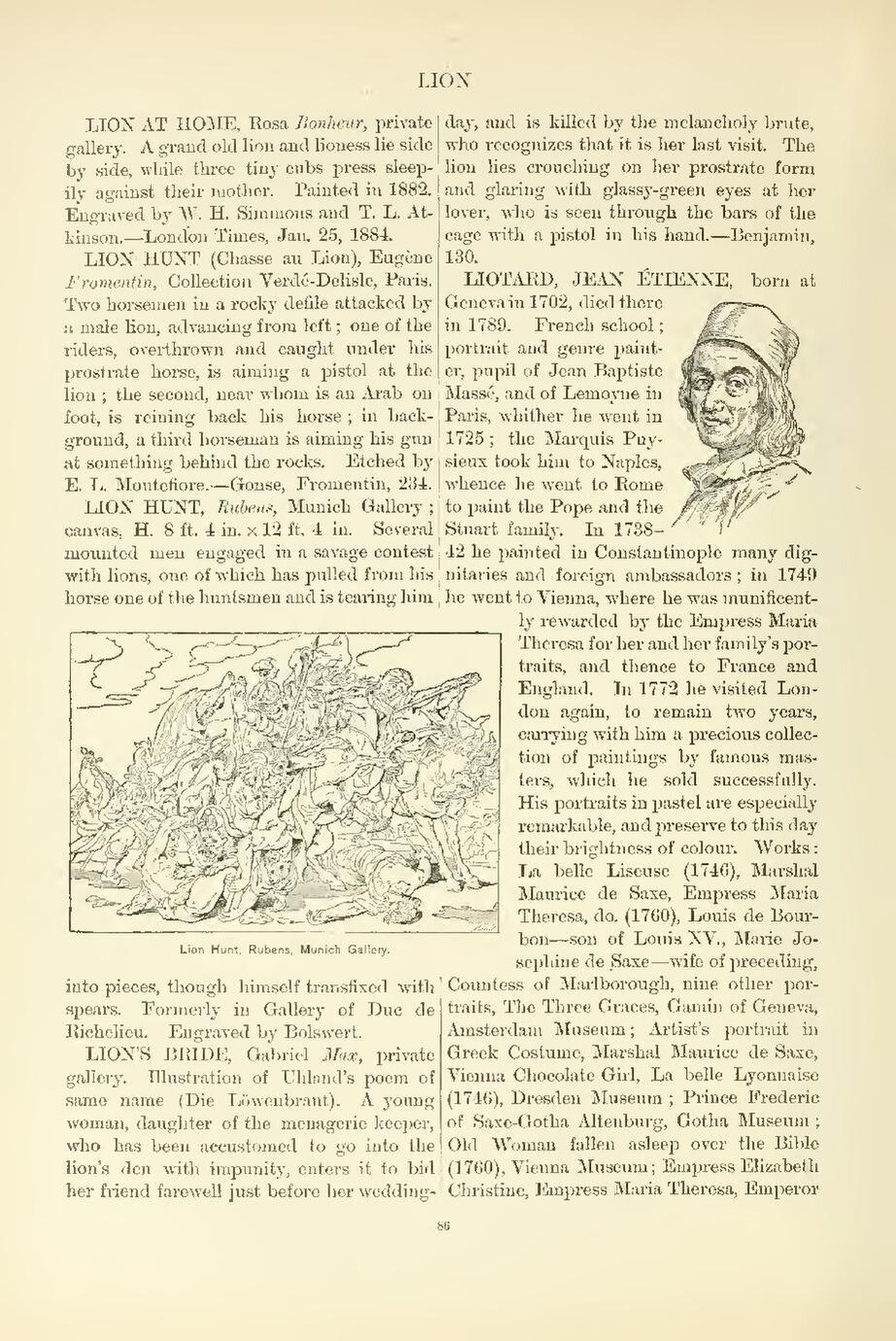LION AT HOME, Rosa Bonheur, private gallery. A grand old lion and lioness lie side by side, while three tiny cubs press sleepily against their mother. Painted in 1882. Engraved by W. H. Simmons and T. L. Atkinson.—London Times, Jan. 25, 1884.
LION HUNT (Chasse au Lion), Eugène
Fromentin, Collection Verdé-Delisle, Paris.
Two horsemen in a rocky defile attacked by
a male lion, advancing from left; one of the
riders, overthrown and caught under his
prostrate horse, is aiming a pistol at the
lion; the second, near whom is an Arab on
foot, is reining back his horse; in background,
a third horseman is aiming his gun
at something behind the rocks. Etched by
E. L. Montefiore.—Gonse, Fromentin, 234.
An image should appear at this position in the text. To use the entire page scan as a placeholder, edit this page and replace "{{missing image}}" with "{{raw image|Cyclopedia of painters and paintings (IA cyclopediaofpain03cham).pdf/108}}". Otherwise, if you are able to provide the image then please do so. For guidance, see Wikisource:Image guidelines and Help:Adding images. |
Lion Hunt, Rubens, Munich Gallery.
LION HUNT, Rubens, Munich Gallery; canvas, H. 8 ft. 4 in. × 12 ft. 4 in. Several mounted men engaged in a savage contest with lions, one of which has pulled from his horse one of the huntsmen and is tearing him into pieces, though himself transfixed with spears. Formerly in Gallery of Duc de Richelieu. Engraved by Bolswert.
LION'S BRIDE, Gabriel Max, private
gallery. Illustration of Uhland's poem of
same name (Die Löwenbraut). A young
woman, daughter of the menagerie keeper,
who has been accustomed to go into the
lion's den with impunity, enters it to bid
her friend farewell just before her wedding-day,
and is killed by the melancholy brute,
who recognizes that it is her last visit. The
lion lies crouching on her prostrate form
and glaring with glassy-green eyes at her
lover, who is seen through the bars of the
cage with a pistol in his hand.—Benjamin,
130.
An image should appear at this position in the text. To use the entire page scan as a placeholder, edit this page and replace "{{missing image}}" with "{{raw image|Cyclopedia of painters and paintings (IA cyclopediaofpain03cham).pdf/108}}". Otherwise, if you are able to provide the image then please do so. For guidance, see Wikisource:Image guidelines and Help:Adding images. |
LIOTARD, JEAN ÉTIENNE, born at
Geneva in 1702, died there
in 1789. French school;
portrait and genre painter,
pupil of Jean Baptiste
Massé, and of Lemoyne in
Paris, whither he went in
1725; the Marquis Puysieux
took him to Naples,
whence he went to Rome
to paint the Pope and the
Stuart family. In 1738-42
he painted in Constantinople many dignitaries
and foreign ambassadors; in 1749
he went to Vienna, where he was munificently
rewarded by the Empress Maria
Theresa for her and her family's portraits,
and thence to France and
England. In 1772 he visited London
again, to remain two years,
carrying with him a precious collection
of paintings by famous masters,
which he sold successfully.
His portraits in pastel are especially
remarkable, and preserve to this day
their brightness of colour. Works:
La belle Liseuse (1746), Marshal
Maurice de Saxe, Empress Maria
Theresa, do. (1760), Louis de Bourbon—son
of Louis XV., Marie Josephine
de Saxe—wife of preceding,
Countess of Marlborough, nine other portraits,
The Three Graces, Gamin of Geneva,
Amsterdam Museum; Artist's portrait in
Greek Costume, Marshal Maurice de Saxe,
Vienna Chocolate Girl, La belle Lyonnaise
(1746), Dresden Museum; Prince Frederic
of Saxe-Gotha Altenburg, Gotha Museum;
Old Woman fallen asleep over the Bible
(1760), Vienna Museum; Empress Elizabeth
Christine, Empress Maria Theresa, Emperor
